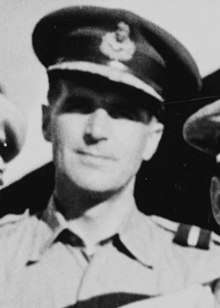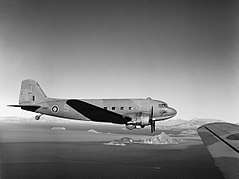Victor Goddard
Air Marshal Sir Robert Victor Goddard, KCB, CBE, DL (6 February 1897 – 21 January 1987) was a senior commander in the Royal Air Force during the Second World War.
Sir Victor Goddard | |
|---|---|
 Air Commodore Victor Goddard in 1943 | |
| Birth name | Robert Victor Goddard |
| Born | 6 February 1897 Wembley, London |
| Died | 21 January 1987 (aged 89) |
| Allegiance | United Kingdom |
| Service/ | Royal Navy (1910–18) Royal Air Force (1918–51) |
| Years of service | 1910–51 |
| Rank | Air Marshal |
| Commands held | Chief of the New Zealand Air Staff (1941–43) No. 30 Squadron RAF (1930–31) |
| Battles/wars | First World War
Second World War
|
| Awards | Knight Commander of the Order of the Bath Commander of the Order of the British Empire Mentioned in Despatches (2) Navy Distinguished Service Medal (United States) |
Goddard is perhaps best known for his interest in paranormal phenomena; he claimed to have witnessed a clairvoyant incident in 1946 on which the feature film The Night My Number Came Up (1955) was later based.
Early life
Goddard was born at Wembley the son of Dr Charles Goddard. After attending St George's School, Harpenden, he went to the Royal Naval Colleges at Osborne and Dartmouth. He served as a midshipman in the first year of the First World War and in 1915 joined the Royal Naval Air Service. At this time he met his lifelong friend Barnes Wallis. For a period he was patrolling for submarines in dirigibles, but in 1916 commanded reconnaissance flights over the Somme battlefield.
Between the wars
In 1921 Goddard was selected to read engineering at Jesus College, Cambridge and then studied at Imperial College London before returning to Cambridge in 1925 as an instructor to the university's air squadron. After graduating from the Royal Naval Staff College in 1929, he commanded a bomber squadron in Iraq. He returned to England in 1931 as chief instructor of the officers' engineering course. He was then at the Staff College until 1935 when he was appointed deputy director of intelligence at the Air Ministry. He held this post until the outbreak of the Second World War.
Goddard later claimed to have had a clairvoyant episode in 1935, at RAF Drem, in Scotland. While the airfield was abandoned at the time, Goddard reportedly saw it as it would appear in 1939, after it had been reactivated.[1]
Second World War
Goddard went with the British Expeditionary Force to France in 1939. He was made senior air staff officer in the following year and played a major part in preserving British air assets in the face of the German attacks. When he returned he became director of military cooperation at the Air Ministry, responsible for "modernising" air support and airborne forces in the RAF. He also made regular air war broadcasts on the BBC.
In September 1941, shortly before the attack on Pearl Harbor, he was appointed as Air Commodore Chief of the Air Staff, Royal New Zealand Air Force (RNZAF). As commander of the RNZAF in the South Pacific, and the only British commander in the region, he was prominent in the operations against the Japanese initial advance. Under Admiral Halsey, US Navy, he commanded the RNZAF in the Battle of Guadalcanal and the Solomon Islands campaigns, for which he was awarded the American Navy Distinguished Service Medal.

Goddard was posted to India in 1943, to take charge of administration for the air command of South East Asia Command (SEAC). He remained in the role until 1946 when he became the RAF's representative in Washington.
He claimed to have witnessed the clairvoyant experience of another officer, in China during January 1946. According to Goddard, he was at a party in Shanghai and scheduled to fly to Tokyo that same night, when he heard of another officer having a dream in which Goddard was killed in a plane crash. In the dream an aircraft was carrying Goddard, two other men and a woman, when it experienced difficulties with atmospheric icing, and crashed on a pebbled beach near mountains. That night Goddard was persuaded to take two men and a woman on the Douglas Dakota transport flying to Tokyo. As in the other's officer's dream, the Dakota plane iced over and was forced to make a crash-landing on the Japanese island of Sado; the crash scene, a pebbled beach near mountains, resembled that described in the dream. Unlike the dream, however, no-one was injured. The 1955 film The Night My Number Came Up was based on this incident that was published in The Saturday Evening Post of May 26, 1951[2]. Michael Redgrave played Goddard, who was depicted in the film as becoming excited as the plane made its crash-landing; this reportedly annoyed Goddard, who had been proud of what he had seen as his unemotional behaviour.
Later life
Goddard retired in 1951, and became principal of the College of Aeronautics, where he remained until 1954. He was also a governor of St George's School Harpenden and of Bryanston School and was president of the Airship Association from 1975 to 1984.
He encouraged Sir George Trevelyan to set up the Wrekin Trust, a body promoting "spiritual education" in 1971. It occupied much of his time in retirement. Through it he became convinced of the reality of the world of the spirit. He spent many years investigating, and lecturing on, flying saucers. On 3 May 1969, he gave a talk on UFOs at Caxton Hall in London, in which he defended the paraphysical hypothesis.[3]
Goddard argued for extrasensory perception and other paranormal phenomena in his book Flight Towards Reality (1975). His claims are disputed by skeptics.[4]
Goddard wrote the foreword to Muriel Dowding's 1980 autobiography and Allan Barham's Strange to Relate (1984).
Family
Goddard married Mildred Catherine Jane Inglis, the daughter of Alfred Inglis and his wife Ernestine (Nina) Pigou (daughter of Francis Pigou, the Dean of Bristol), in 1924. Their daughter, Jane Helen Goddard, was married to Sir Robin Chichester-Clark.
Publications
- The Enigma of Menace (1959)
- Flight Towards Reality (1975)
- Skies to Dunkirk, (1982)
References
- Goddard, Victor (1975). Flight Towards Reality. UK: Turnstone. ISBN 978-0-85500-045-5.
- https://www.ebay.com/itm/1951-Saturday-Evening-Post-May-26-Eva-Peron-Jerome-AZ-/170618293175
- John Keel (1996). Operation Trojan Horse (PDF). pp. 39–40. ISBN 978-0962653469. Archived from the original (PDF) on 20 April 2013.. Originally published in 1970.
- Smith, Blake. (2015). "Should Goddard’s Squadron Drop Dead Fred?" Skeptic. Retrieved 4 May 2017.
External links
- Air of Authority – A History of RAF Organisation – Air Mshl Sir Victor Goddard
- Imperial War Museum Interview from 1973
- Imperial War Museum Interview from 1978
| Military offices | ||
|---|---|---|
| Preceded by Group Captain Hugh Saunders |
Chief of the Air Staff (RNZAF) 1941–1943 |
Succeeded by Air Vice Marshal Leonard Isitt |